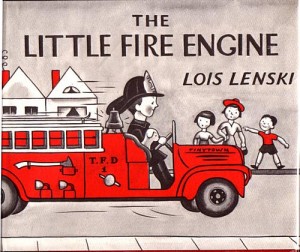If you like this review, you can give it a thumbs up or comment on Amazon.
All children’s books do not age equally.
In some cases, like the nature stories of Eric Carle or the epics of Margaret Wise Brown, the date of the story is almost invisible, because the subject is so universal and well-told. In other cases, like The Little Engine That Could, we understand that this is an “old story,” but the message is important enough that we can look past or even enjoy its age. Age might even be a teachable moment, to explain to our children that things change over time.
The fatal problem with The Little Fire Engine isn’t that it is poorly written or poorly illustrated; in many ways it is a beautiful book. The problem is that any childrens’ story about fires and fire fighters will necessarily have to deal with safety, and while Lenski has given careful attention to the sounds and appearances of the the fire engine, she has neglected the proper response to a fire, which was just as important in 1946 as it is in the 2000s.
The most obvious example of this is what happens when Fireman Small arrives at the scene of the fire: “The family carry sofa, lamps, tables, and chairs out of the house.” Several pages later:
‘”Oh, look!” Everybody looks. A little girl is standing at the upstairs window. She has a kitten in her arms.’
What kind of family is this that meticulously saves all of their furniture but hasn’t cleared their children from danger? And to take the complaint a little further, what is the importance of material possessions next to human life?
A few pages later, Fireman Small steps onto the roof and starts whacking at the roof with his axe. This makes him a very bad fire fighter; real fire-fighters don’t gamble with their lives. They test the sturdiness of anything they’re standing on, and most often, their efforts are directed at the source of the fire, lower down, instead of the tips of the flames.
Positive reviewers argue that the datedness of this book can be ignored or embraced. It’s well crafted and well designed, and we shouldn’t worry about the fact that the pictures are old-fashioned. They are right that these are not issues, and it is an attractive book. However, as an introduction to the nature of fire and fire-fighting, The Little Fire Engine fails at all of its most important tasks. It is not enough for such a book to show a well-drawn fire-engine and its scrappy little driver. Parents and readers would be better served to find a book that can balance a spirited and well-crafted telling with the seriousness of fires and the importance of safety.
